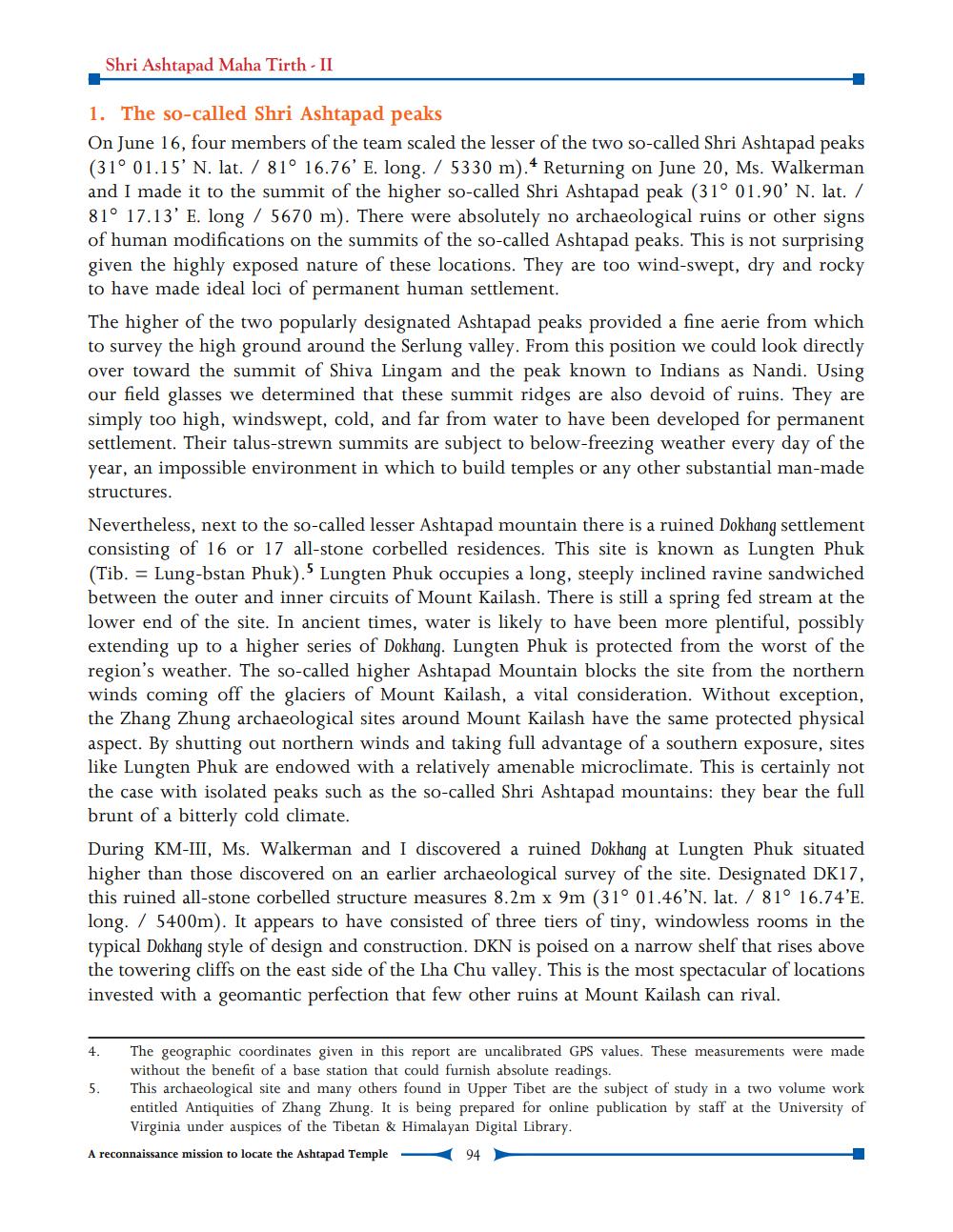________________
Shri Ashtapad Maha Tirth - II
1. The so-called Shri Ashtapad peaks On June 16, four members of the team scaled the lesser of the two so-called Shri Ashtapad peaks (31° 01.15' N. lat. / 81° 16.76' E. long. / 5330 m). Returning on June 20, Ms. Walkerman and I made it to the summit of the higher so-called Shri Ashtapad peak (31° 01.90' N. lat. / 81° 17.13' E. long / 5670 m). There were absolutely no archaeological ruins or other signs of human modifications on the summits of the so-called Ashtapad peaks. This is not surprising given the highly exposed nature of these locations. They are too wind-swept, dry and rocky to have made ideal loci of permanent human settlement. The higher of the two popularly designated Ashtapad peaks provided a fine aerie from which to survey the high ground around the Serlung valley. From this position we could look directly over toward the summit of Shiva Lingam and the peak known to Indians as Nandi. Using our field glasses we determined that these summit ridges are also devoid of ruins. They are simply too high, windswept, cold, and far from water to have been developed for permanent settlement. Their talus-strewn summits are subject to below-freezing weather every day of the year, an impossible environment in which to build temples or any other substantial man-made structures. Nevertheless, next to the so-called lesser Ashtapad mountain there is a ruined Dokhang settlement consisting of 16 or 17 all-stone corbelled residences. This site is known as Lungten Phuk (Tib. = Lung-bstan Phuk). Lungten Phuk occupies a long, steeply inclined ravine sandwiched between the outer and inner circuits of Mount Kailash. There is still a spring fed stream at the lower end of the site. In ancient times, water is likely to have been more plentiful, possibly extending up to a higher series of Dokhang. Lungten Phuk is protected from the worst of the region's weather. The so-called higher Ashtapad Mountain blocks the site from the northern winds coming off the glaciers of Mount Kailash, a vital consideration. Without exception, the Zhang Zhung archaeological sites around Mount Kailash have the same protected physical aspect. By shutting out northern winds and taking full advantage of a southern exposure, sites like Lungten Phuk are endowed with a relatively amenable microclimate. This is certainly not the case with isolated peaks such as the so-called Shri Ashtapad mountains: they bear the full brunt of a bitterly cold climate. During KM-III, Ms. Walkerman and I discovered a ruined Dokhang at Lungten Phuk situated higher than those discovered on an earlier archaeological survey of the site. Designated DK17, this ruined all-stone corbelled structure measures 8.2m x 9m (31° 01.46'N. lat. / 81° 16.74'E. long. / 5400m). It appears to have consisted of three tiers of tiny, windowless rooms in the typical Dokhang style of design and construction. DKN is poised on a narrow shelf that rises above the towering cliffs on the east side of the Lha Chu valley. This is the most spectacular of locations invested with a geomantic perfection that few other ruins at Mount Kailash can rival.
4. The geographic coordinates given in this report are uncalibrated GPS values. These measurements were made
without the benefit of a base station that could furnish absolute readings. 5. This archaeological site and many others found in Upper Tibet are the subject of study in a two volume work
entitled Antiquities of Zhang Zhung. It is being prepared for online publication by staff at the University of
Virginia under auspices of the Tibetan & Himalayan Digital Library. A reconnaissance mission to locate the Ashtapad Temple - 94




